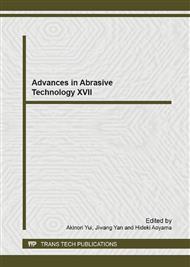p.735
p.741
p.747
p.753
p.758
p.764
p.770
p.776
p.782
Smoothed Particle Hydrodynamics Simulations for Ultrasonic Machining of Different Workpiece Materials
Abstract:
The material removal in ultrasonic machining (USM) is based on brittle fracturing of workpiece materials. The properties and fracture behavior are different for varied materials, and they would have an influence on the machining performance of USM. The smoothed particle hydrodynamics (SPH) method was used to simulate the USM process for different workpiece materials. Three typical hard and brittle materials, i.e. silicon carbide (SiC), alumina (Al2O3), and glass will be used as the workpiece materials. Experiments are also conducted for comparing with the simulation results. Through this study, the material fracturing processes for different work materials are shown visually using the SPH method, which is very useful for USM study.
Info:
Periodical:
Pages:
758-763
Citation:
Online since:
September 2014
Authors:
Price:
Сopyright:
© 2014 Trans Tech Publications Ltd. All Rights Reserved
Share:
Citation:


